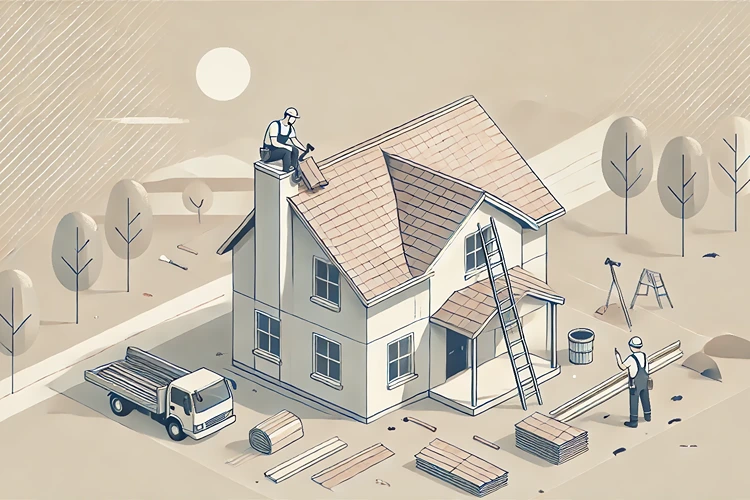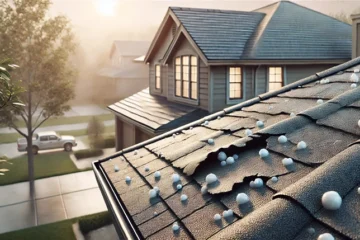Roof Replacement Cost Breakdown and Budgeting Tips

When it’s time to replace your roof, the costs can seem daunting. But understanding the breakdown of expenses and budgeting effectively can make the process less stressful. This guide will walk you through the various factors that influence roof replacement costs and offer practical tips to help you manage your budget. Whether you’re dealing with a small leak or a complete overhaul, knowing what to expect financially can save you from unexpected surprises.
What Factors Influence Roof Replacement Costs?
The cost of replacing a roof can vary significantly depending on several factors. It’s important to understand these elements so you can better anticipate your expenses and plan accordingly.
1. Type of Roofing Material
The type of material you choose for your new roof is one of the most significant factors in determining the overall cost. Here’s a quick look at some common roofing materials:
- Asphalt Shingles: Generally the most affordable option, with prices ranging from $100 to $200 per square foot.
- Metal Roofing: Known for durability, metal roofs cost between $300 to $600 per square foot.
- Wood Shingles: Offering a natural look, wood shingles can cost around $400 to $700 per square foot.
- Tile Roofing: Tiles are more expensive, typically ranging from $600 to $1,000 per square foot, but they offer longevity and aesthetic appeal.
- Slate Roofing: One of the most expensive options, slate can cost between $1,000 to $2,000 per square foot but is known for its durability and timeless look.
Each material comes with its pros and cons, affecting not just the initial cost but also long-term maintenance expenses. Your choice should align with your budget, climate, and the aesthetic you wish to achieve.
Average Roof Lifespan by Material
| Roofing Material | Average Lifespan (Years) |
|---|---|
| Asphalt Shingles | 15-30 |
| Metal Roofing | 40-70 |
| Wood Shingles | 25-35 |
| Tile Roofing | 50-100 |
| Slate Roofing | 75-200 |
Helpful Hint:
Consider the long-term value of your roofing material. While asphalt shingles may be cheaper upfront, options like metal or tile can offer better durability and energy efficiency, potentially saving you money in the long run.
2. Roof Size and Pitch
The size of your roof is directly proportional to the cost of replacement. Roofers typically charge per square foot, so larger roofs will naturally incur higher costs. Additionally, the pitch (or slope) of your roof affects the difficulty of the installation. Steeper roofs require more labor and specialized equipment, increasing the overall cost.
Stats:
According to a recent survey, the average cost per square foot for a roof replacement in the U.S. is approximately $350. This means that for a 2,000 square foot roof, homeowners can expect to pay around $7,000 on average.
3. Removal of Old Roof
Before installing your new roof, the old one must be removed. This process involves labor and disposal fees, which can add to the total cost. The complexity of the removal depends on the number of layers and the type of material being removed. If your old roof is particularly difficult to remove, expect the costs to rise.
4. Roof Accessibility
How easily roofers can access your roof also affects the cost. If your roof is difficult to reach, or if there are obstacles such as trees or power lines, the job becomes more complicated and time-consuming, leading to higher labor costs.
5. Geographic Location
Where you live plays a role in roof replacement costs. Labor rates and material costs can vary significantly from one region to another. Urban areas typically have higher costs due to increased labor rates, while more rural areas may have lower costs. Additionally, the local climate can affect the type of materials needed, further influencing the overall cost.
6. Additional Features and Upgrades
If you’re considering adding features like skylights, chimneys, or roof insulation, these will add to your overall costs. While these features can enhance the functionality and aesthetics of your home, they require additional materials and labor, which can significantly increase your budget.
Helpful Hint:
When budgeting for a roof replacement, it’s wise to set aside an additional 10-15% of your budget for unexpected expenses. Whether it’s discovering rotten wood that needs replacing or deciding on an upgrade, having a financial cushion can prevent budget overruns.
How to Budget for a Roof Replacement
Now that you understand the factors influencing roof replacement costs, it’s time to discuss how to budget for this significant home improvement project. Proper budgeting will ensure you’re financially prepared and help avoid any surprises during the process.
1. Get Multiple Quotes
One of the best ways to ensure you’re getting a fair price is to obtain multiple quotes from different roofing contractors. This not only helps you compare prices but also gives you an idea of the range of services offered. Be sure to compare each quote carefully, taking into account the materials used, labor costs, and any additional services provided.
2. Consider Financing Options
If paying for a roof replacement upfront isn’t feasible, consider financing options. Many roofing companies offer payment plans or financing through third-party lenders. Alternatively, you might look into a home equity loan or a personal loan. Financing allows you to spread the cost over time, making it more manageable within your monthly budget.
Stats:
Studies show that over 60% of homeowners use some form of financing for major home improvement projects, including roof replacements. This makes it crucial to explore various financing options to find one that fits your financial situation.
3. Plan for Seasonal Discounts
Roofing companies often offer discounts during certain times of the year, particularly during the off-season. If possible, plan your roof replacement during these times to take advantage of potential savings. Additionally, purchasing materials in advance when prices are lower can also help reduce costs.
4. Allocate Funds for Maintenance
Don’t just budget for the replacement itself; consider setting aside funds for ongoing maintenance. Regular inspections and minor repairs can extend the life of your new roof, protecting your investment and preventing the need for another costly replacement in the near future.
Helpful Hint:
Consider setting up a dedicated home maintenance fund where you regularly contribute a small amount. This fund can be used for routine maintenance or unexpected repairs, ensuring you’re always prepared for any roofing issues that arise.
Is Roof Replacement a Good Investment?
Replacing a roof is undoubtedly a significant expense, but it’s also an investment in your home’s value and safety. Here’s why it’s worth considering:
1. Increases Home Value
A new roof can significantly increase your home’s value, making it more appealing to potential buyers. In fact, many real estate experts agree that a new roof can offer a return on investment of up to 70%, depending on the material and the quality of the installation.
2. Improves Energy Efficiency
Modern roofing materials are designed to be more energy-efficient, helping to keep your home cooler in the summer and warmer in the winter. This can lead to lower energy bills, saving you money over time.
3. Enhances Curb Appeal
A new roof can dramatically improve the appearance of your home. Whether you’re looking to sell or simply want to enhance your home’s curb appeal, a roof replacement can make a big difference in how your home looks from the outside.
Stay tuned for the next part of this article, where we’ll delve deeper into additional considerations, including how to choose the right contractor and what to expect during the roof replacement process.
How to Choose the Right Contractor for Your Roof Replacement
Choosing the right contractor is crucial to ensure your roof replacement is done correctly and within budget. Here are some tips to help you find a reliable and experienced roofing contractor.
1. Check for Proper Licensing and Insurance
Before hiring a contractor, make sure they have the necessary licenses and insurance required in your state. A licensed contractor is more likely to be reputable and knowledgeable about local building codes and regulations. Insurance is equally important as it protects you from liability in case of accidents or damage during the project.
Ask the contractor to provide proof of both licensing and insurance. If they hesitate or cannot provide the documentation, it’s a red flag that you might want to consider someone else.
2. Look for Experience and Expertise
Experience matters when it comes to roof replacement. A contractor with years of experience is more likely to have encountered and solved a wide range of roofing issues. Look for contractors who specialize in the type of roof you’re installing, whether it’s asphalt shingles, metal, tile, or another material. This ensures they have the specific expertise needed to handle your project efficiently.
Helpful Hint:
Ask potential contractors for a portfolio of their previous work or references from past clients. This gives you a chance to see the quality of their work and hear about others’ experiences working with them.
3. Read Reviews and Ask for Recommendations
Online reviews can provide valuable insights into a contractor’s reputation. Look for reviews on trusted platforms like Google, Yelp, or the Better Business Bureau. Pay attention to any recurring themes in the reviews, such as consistent praise for punctuality and professionalism, or repeated complaints about poor communication or missed deadlines.
In addition to online reviews, ask friends, family, or neighbors for recommendations. Personal experiences can often provide a clearer picture of what to expect from a contractor.
4. Get Detailed Estimates
Once you’ve narrowed down your list of potential contractors, ask each one for a detailed estimate. This estimate should include the cost of materials, labor, and any additional fees. Make sure it’s itemized, so you can see exactly what you’re paying for.
Avoid contractors who give you vague or overly simple estimates, as this could lead to unexpected costs down the line. A detailed estimate helps ensure transparency and allows you to compare prices more accurately between different contractors.
5. Communication and Professionalism
Effective communication is key to a successful roofing project. Pay attention to how responsive and clear the contractor is during your initial interactions. A contractor who is easy to communicate with and addresses your questions and concerns promptly is more likely to be reliable throughout the project.
Professionalism also matters. This includes everything from showing up on time for meetings to the way they present their contract and handle negotiations. A professional contractor will respect your time, home, and budget.
What to Expect During the Roof Replacement Process
Understanding the roof replacement process can help you prepare for what’s to come and ensure the project goes smoothly. Here’s a step-by-step overview of what to expect:
1. Initial Inspection and Assessment
Before the work begins, the contractor will perform a thorough inspection of your roof. This involves assessing the condition of your existing roof, identifying any underlying issues, and taking measurements. This step helps the contractor determine the scope of the project and provide a more accurate estimate.
2. Removing the Old Roof
The first major task in roof replacement is removing the old roofing material. This process can take a day or more, depending on the size of your roof and the number of layers being removed. The contractor will use specialized tools to strip away the old material, revealing the roof deck underneath.
During this time, your home will be exposed to the elements, so it’s important that the contractor works efficiently to minimize exposure. They may use tarps or other coverings to protect your home while the old roof is being removed.
3. Inspecting the Roof Deck
Once the old roof is removed, the contractor will inspect the roof deck for any signs of damage, such as rot or warping. If any issues are found, they will need to be repaired or replaced before the new roofing material can be installed. This step is crucial for ensuring the structural integrity of your new roof.
4. Installing the New Roof
With the roof deck prepared, the contractor will begin installing the new roofing material. This involves laying down a water-resistant underlayment, followed by the roofing material you’ve chosen. The installation process varies depending on the type of material, but it generally involves securing each piece in place with nails, screws, or adhesive.
The contractor will also install flashing around any roof penetrations, such as chimneys, vents, or skylights, to prevent leaks. Proper installation of these components is essential for ensuring your roof is weatherproof and durable.
5. Cleanup and Final Inspection
After the new roof is installed, the contractor will clean up the job site, removing any debris, nails, and leftover materials. They should leave your property looking as clean as it was before the project began.
Finally, the contractor will conduct a final inspection of the roof to ensure everything is installed correctly and meets local building codes. They may also walk you through the work they’ve done and address any final questions or concerns you might have.
6. Post-Installation Maintenance
Once your new roof is in place, regular maintenance is key to ensuring its longevity. Schedule periodic inspections, especially after severe weather, to catch any issues early. Cleaning gutters, removing debris, and checking for signs of wear can all help extend the life of your new roof.
Helpful Hint:
Keep a record of your roof replacement, including the contractor’s contact information, warranty details, and any receipts or paperwork. This documentation will be useful for future maintenance or if you decide to sell your home.
FAQs
Wrapping Up
Replacing your roof is a significant investment that can enhance your home’s value, safety, and energy efficiency. By understanding the cost breakdown and budgeting effectively, you can navigate the process with confidence and ensure the best outcome for your home. Remember to choose a reputable contractor, plan for potential costs, and consider the long-term benefits of your new roof. With careful planning and attention to detail, your roof replacement can be a seamless and rewarding experience that protects your home for years to come.


